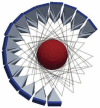The clinical utilities of multi-pinhole single photon emission computed tomography
- PMID: 33014732
- PMCID: PMC7495312
- DOI: 10.21037/qims-19-1036
The clinical utilities of multi-pinhole single photon emission computed tomography
Abstract
Single photon emission computed tomography (SPECT) is an important imaging modality for various applications in nuclear medicine. The use of multi-pinhole (MPH) collimators can provide superior resolution-sensitivity trade-off when imaging small field-of-view compared to conventional parallel-hole and fan-beam collimators. Besides the very successful application in small animal imaging, there has been a resurgence of the use of MPH collimators for clinical cardiac and brain studies, as well as other small field-of-view applications. This article reviews the basic principles of MPH collimators and introduces currently available and proposed clinical MPH SPECT systems.
Keywords: Single photon emission computed tomography (SPECT); brain; cardiac; collimator; multi-pinhole.
2020 Quantitative Imaging in Medicine and Surgery. All rights reserved.
Conflict of interest statement
Conflicts of Interest: All authors have completed the ICMJE uniform disclosure form (available at http://dx.doi.org/10.21037/qims-19-1036). FJB reports personal fees and non-financial support from MILabs, grants from Dutch Foundation for Scientific Research (NWO), during the conduct of the study. In addition, FJB has patents on several pinhole imaging devices issued. He is founder, shareholder, and part time CEO of MILabs B.V, a company that develops pinhole PET and SPECT systems like the U-SPECT and G-SPECT-I scanners that were addressed in the present paper. GSPM reports that she has a patent “Optimized Multi-Pinhole Collimator for Dual-Purpose Clinical and Preclinical Imaging” (US 9,431,140 B2) issued. In addition, GSPM serves as an unpaid editorial board member of Quantitative Imaging in Medicine and Surgery. The other authors have no conflicts of interest to declare.
Figures


























Similar articles
-
Design and evaluation of two multi-pinhole collimators for brain SPECT.Ann Nucl Med. 2017 Oct;31(8):636-648. doi: 10.1007/s12149-017-1195-y. Epub 2017 Jul 28. Ann Nucl Med. 2017. PMID: 28755084
-
Advances in pinhole and multi-pinhole collimators for single photon emission computed tomography imaging.World J Nucl Med. 2015 Jan-Apr;14(1):3-9. doi: 10.4103/1450-1147.150505. World J Nucl Med. 2015. PMID: 25709537 Free PMC article. Review.
-
Primary, scatter, and penetration characterizations of parallel-hole and pinhole collimators for I-123 SPECT.Phys Med Biol. 2019 Dec 13;64(24):245001. doi: 10.1088/1361-6560/ab58fe. Phys Med Biol. 2019. PMID: 31746783 Free PMC article.
-
Performance evaluation of a novel multi-pinhole collimator for dopamine transporter SPECT.Phys Med Biol. 2020 Aug 21;65(16):165015. doi: 10.1088/1361-6560/ab9067. Phys Med Biol. 2020. PMID: 32369781
-
Review of SPECT collimator selection, optimization, and fabrication for clinical and preclinical imaging.Med Phys. 2015 Aug;42(8):4796-813. doi: 10.1118/1.4927061. Med Phys. 2015. PMID: 26233207 Free PMC article. Review.
Cited by
-
Characterization of accurate 3D collimator-detector response function for single- and multi-lofthole collimated SPECT cameras.Jpn J Radiol. 2024 Nov;42(11):1330-1341. doi: 10.1007/s11604-024-01624-1. Epub 2024 Jul 2. Jpn J Radiol. 2024. PMID: 38954193
-
Multi-pinhole collimator design in different numbers of projections for brain SPECT.Front Med (Lausanne). 2023 Sep 28;10:1211726. doi: 10.3389/fmed.2023.1211726. eCollection 2023. Front Med (Lausanne). 2023. PMID: 37841005 Free PMC article.
-
Examination of aperture layout designs for an adaptive-stationary multi-pinhole brain-dedicated SPECT system.Med Phys. 2025 Jun;52(6):3734-3759. doi: 10.1002/mp.17866. Epub 2025 May 11. Med Phys. 2025. PMID: 40350971
-
Performance evaluation of a novel multi-pinhole collimator on triple-NaI-detector SPECT/CT for dedicated myocardial imaging.EJNMMI Phys. 2023 Mar 25;10(1):24. doi: 10.1186/s40658-023-00541-y. EJNMMI Phys. 2023. PMID: 36964406 Free PMC article.
-
Sex-specific reference limits of left ventricular ejection fraction and volumes estimated by gated myocardial perfusion imaging for low-risk patients in China: a comparison between three quantitative algorithms.Quant Imaging Med Surg. 2022 Jan;12(1):144-158. doi: 10.21037/qims-21-347. Quant Imaging Med Surg. 2022. PMID: 34993067 Free PMC article.
References
Publication types
LinkOut - more resources
Full Text Sources
